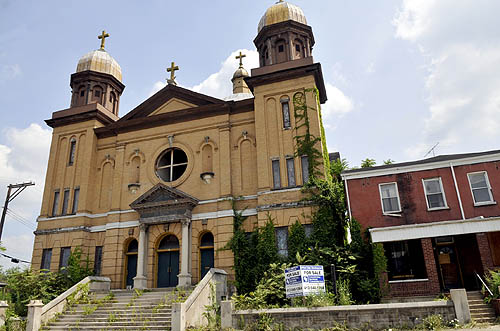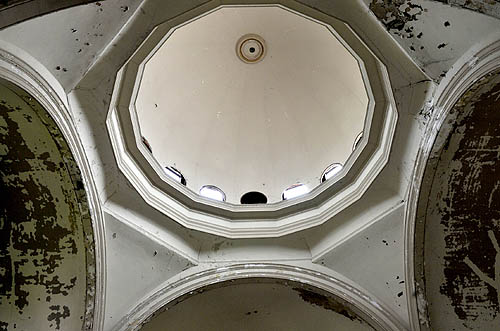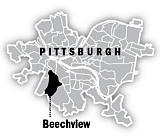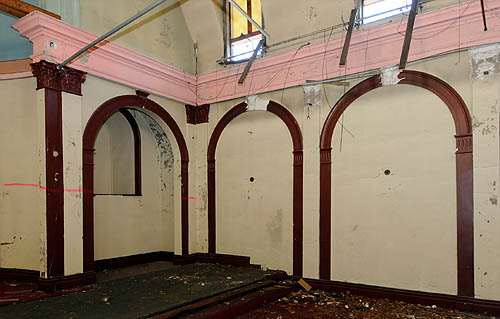
Category Archive: Property for Sale
-
Buying Here: Larimer
Saturday, November 20, 2010By Gretchen McKay, Pittsburgh Post-GazetteOur Lady Help of Christians in Larimer was barely 5 years old when fire ripped through it in 1905, destroying the church at the corner of Meadow and Turrett streets. The Italian immigrants who had guided its construction in 1898, though, were a resolute bunch.
Within a year they’d rebuilt the Baroque-style structure, and until it closed in 1992, Help of Christians served as a center of Italian-American religious and social life, hosting not just Catholic Masses but everything from the annual celebration in honor of St. Agnello Abate to an array of sporting activities for neighborhood kids.
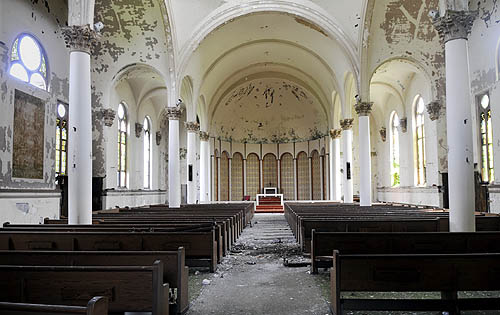
The ceiling and plaster walls have peeling paint at the former Our Lady of Help Christians church in Larimer. J. Monroe Butler II/Post-Gazette
Like many churches in the city, however, its parish aged and dwindled and was merged in the 1990s with five others to form St. Charles Lwanga parish in Lincoln-Lemington. In 1995, the Pittsburgh Catholic Diocese sold the church, which has a banquet hall in the lower level, and adjacent rectory to Heavenly Vision Ministries.
Three years ago, Heavenly Vision put 6513 Meadow St. back on the market, at first quietly through word of mouth, and then last year officially for $169,000 through Coldwell Banker Real Estate’s Fox Chapel office (www.pittsburghmoves.com; MLS No. 838378; 412-963-7655).
 Larimer
Larimer
At a glance- Website: www.city.pittsburgh.pa.us/district9/
- Size: .445 square miles
- Population: 2,602 (2000 census)
- School district: Pittsburgh Public, pghboe.net
- Enrollment: About 28,000
- Average 2010 SAT scores: (Peabody High School) 379 verbal; 410 math; 380 writing
- Taxes for a property assessed at $100,000 *: $2,870; City: $1,080 (10.8 mills); School district: $1,392 (13.92 mills); County: $398 (4.69 mills)
- Wage tax: 3 percent (1 percent to the city, 2 percent to the school district)
- Bet you didn’t know: Originally settled by Germans in the mid-1800s, Larimer was Pittsburgh’s “Little Italy” until the 1960s. It is named for railroad magnate and radical abolitionist General William Larimer, who built a manor home overlooking East Liberty along a path that would eventually become known as Larimer Avenue.
* Includes the Act 50 Homestead Exclusion, which reduces assessed market value by $15,000 for county taxes.Time has not been kind to Help of Christians, which could accommodate up to 1,000 worshippers in the nave and balcony in its heyday in the ’50s and ’60s. The amount of repairs necessary to breathe life back into the property are pretty extensive.
There is no glass in its long, arched windows and holes in the roof. The coved ceiling and plaster walls are peeling paint. Vandals have broken the pews and stolen the pipes from the organ. Carpeting is matted with dust, debris and pigeon feathers. The hand-painted frescoes that brightened the chancel are so badly faded and tarnished you almost can’t tell they were ever there. There’s no heat or water.
“People go in an ooh and aah over the architecture, but it’s a broken structure,” says Realtor Ted Harchick, who shares the “as-is” listing with Dan Boehler.
Adding insult to injury are the many thefts that have stripped the space of most everything of architectural significance. Only a handful of the dozens of original stained-glass windows remain. And it’s only because they’re too heavy to lift that looters also didn’t carry away the marble communion rails in the chancel.
Most heartbreaking is the massive circular window that crowned the front door. Somehow, the robbers managed to sneak the stained glass out of the wood framing in the stealth of night.
Vandals also have trashed the 6,000-square-foot rectory, which during Heavenly Vision Ministries’ tenure housed Family Options Foster Care, in addition to church offices. The property’s current market value is $256,400 ($172,900 for the church and $83,500 for the rectory). Taxes are in arrears on the rectory.
“It’s not for the faint of heart,” admits Mr. Harchick. “We need a risk-taker.”
On the plus side is its location in Larimer. Developments such as Bakery Square, a new “lifestyle center” in the old Nabisco plant on Penn Avenue, are helping to make one of Pittsburgh’s poorest neighborhoods attractive to national retailers and other businesses. UPMC, for instance, is planning to open a technology development center there by the end of the year, and Free People, a hip clothing boutique, follows on the heels of Anthropologie this winter. Next year, a $1.8 million, 14,500-square-foot vocational center funded by the Urban Redevelopment Authority and the Small Business Administration will open not far from the church on Meadow Street.
The Rev. Armenia Johnson, leader of Heavenly Vision Ministries, says she will be very careful in selecting a buyer for the old church.
“We want them to restore it into something that is beneficial and positive for this community,” she says.
In other words, if you’re thinking “brew house” or “night club,” it’s probably not going to fly.
Rev. Johnson, who is now associate pastor of St. James Baptist in Homewood, paid $100,000 the property in 1995. Although the Garfield native did her best to maintain the elegant building, she never had the funding she needed to properly maintain or improve it. So bit by bit, the once grand structure fell into terrible disrepair.
It’s a common fate for churches, which account for a growing number of real estate listings thanks to declining membership and consolidations. According to RealSTATS, a South Side-based real estate information company, 45 churches have changed hands in Allegheny and surrounding counties since January 2009, with sales prices ranging from $5,000 for Ambassador Baptist Church in Ross to $1.1 million for Christian Community Church in Adams.
Occasionally one will make the transition from place of worship to heavenly home. But given the high redevelopment costs, it often takes a grand idea — restaurant, performance hall, multi-unit condo development — and corporate investors to fill such a grand space. CVS, for example, bought the church in Adams. Most are purchased as-is by other religious organizations, or they languish on the market for years.
“You definitely don’t have as many players,” notes Tom Conroy of Howard Hanna Real Estate Services, who has sold so many churches for Hanna’s commercial division that he’s known as The Church Guy.
Mr. Conroy’s current listings include Harvest Baptist Church in New Kensington ($199,000; MLS No. QL102931); St. Michael Church ($250,000; MLS No. QL103962) in Munhall; and St. Mary Magdalene ($159,000; MLS No. QL103653) in Homestead.
Financing, zoning and parking all can be challenges. Many older churches were built in walkable residential areas that prohibit commercial enterprises. Former parishioners add to the difficulty. Even after religious artifacts have been removed and the building is just a building, some stay emotionally attached.
“Significant events take place there,” says Mr. Conroy. “Marriages, baptisms, funerals.”
-
T & T Hardware Closing After 74 Years
Friday, November 19, 2010By Emily Gibb, Pittsburgh Post-Gazette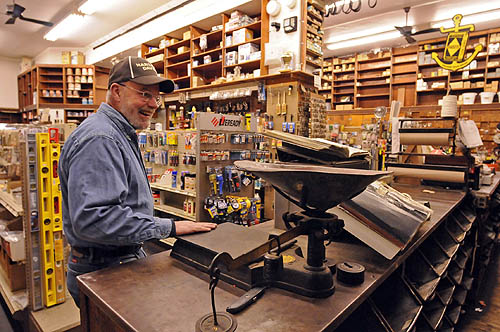
Manager Mark McNally is winding down business at T & T Hardware, a fixture at 2114 East Carson St. on the South Side since 1936. Owned by the Tumas family since its founding, the store has found it impossible to compete with big-box retailers. The scale, which has weighed countless nails and screws for sale by the pound, will remain with the Tumas family. Everything else will be marked down 50 percent Monday morning. Bob Donaldson/Post-Gazette
Pull open the solid wood door with its weathered red paint, walk into T & T Hardware Co. Inc. on the South Side and it’s a bit like stepping back in time.
Wooden shelves line the walls, some all the way to the ceiling, along with rows and rows of little wooden drawers full of screws, nuts and bolts behind a wooden counter along the back. Power tools almost seem out of place in their wood and glass displays.
But next week, after fighting off hard times the last few years, the hardware store fixture on Carson Street begins the process to shut its doors for good.
The “mom and pop” store has too much remaining inventory to liquidate or auction off yet, so beginning Monday, everything is 50 percent off the original price, said manager Mark McNally, 55, of Mount Washington.
They are waiting to see how long it takes to sell most of their inventory to set an exact closing date. This week, they’re just trying to get everything out on the shelves.
Stanley Tumas opened T & T Hardware in 1936. After he retired in the late 1980s, his son, Michael Tumas, took over ownership of the store.
It has stayed in the same spot for the last 74 years, expanding to the side and to the back as the years went on. It was a work in progress until the ’80s, Mr. McNally said.
He says they’ve always had a reputation as the place to go for “odd stuff that no one else has,” like specific plumbing parts, nuts, bolts or screws.
Since he began working at a hardware store in Mount Washington as a teenager and then managing T & T Hardware for the last 15 years, Mr. McNally has seen many changes in the business.
Part of the challenge comes from “big box” stores, like Home Depot. “They’re key why these stores are going,” he said.
Competing with a Lowe’s only five miles away has been difficult.
“It’s just too close. I can show you on my books when they opened,” he said.
Besides competing with large chains, they are competing with the economy as well.
A lot of their business used to come from commercial contractors, but if the contractors don’t have jobs to do, they won’t be coming the hardware store for supplies.
On top of the struggling economy, the South Side is a changing neighborhood.
“For a store like this, the neighborhood has to support it,” he said.
But most people in the neighborhood now rent their houses. Generally, renters aren’t in need of hardware supplies when they can just call their landlord to take care of things.
Saturday used to be the busiest day of the week for a hardware store, Mr. McNally said. Customers who had the day off work would buy their home improvement supplies in the morning. If they were having problems, they would return around noon. If they were really having problems, they would be back again around 3 p.m., Mr. McNally said.
But last year, he started closing on Saturdays — they didn’t have enough weekend business to make it worthwhile anymore.
At one time there were four or five hardware stores just on the South Side, but, he says, “times change. I understand that.”
As Mr. McNally starts a new phase, he has to say goodbye to more than a store and a building.
“The people, without a doubt — that’s what I’m going to miss the most. After 15 years you make good, good friends,” he said.
-
South Side Hardware Store Ends 74-Year Run
By Craig Smith, PITTSBURGH TRIBUNE-REVIEW
Wednesday, November 17, 2010Pittsburgh’s South Side was a different neighborhood in 1936 when Stanley J. Tumas scraped together $800 to open his T&T Hardware store on East Carson Street.
“It was an old ethnic neighborhood. People took pride in that neighborhood,” said his son, Mike Tumas, 59, of Coudersport, Potter County, who has decided to close the store his father started 74 years ago.
The hardware store became a staple of the neighborhood anchored by the nearby J&L Steel mill, he said.
“Guys would get laid off. Their wives would say, ‘You’re painting the house,’ ” Mike Tumas said. “We did well. We did a good business.”
And the business grew over the years. It doubled in size when Stanley Tumas knocked down a wall separating the building.
Father and son worked hard.
“You spent vacations, days off, working at the store,” Mike Tumas said. “That was our life.”
But T&T and other neighborhood hardware stores found it hard to compete with big box chain stores and a changing market. Modernization — fax machines and computers — proved difficult for veteran shopkeepers used to sales receipt books with 50 pages in them, Mike Tumas said.
“My dad’s idea of a fax machine was to hand you a receipt and say, ‘Run this down the corner,’ ” Mike Tumas said.
Three people will lose their jobs when T&T closes before the end of the year. Tumas said he tried to sell the business but found no takers. He plans to sell the building.
“A lot of commercial accounts told me they were leaving Pittsburgh and Allegheny County because of the taxes,” he said. “What commercial businesses are on the South Side anymore?”
Hardware stores used to dot the area — three in Mt. Washington, two in Allentown, four in the South Side.
“We ran longer than most,” said Mark McNally, T&T’s manager.
It was an uphill run.
Home Depot said its sales during the third quarter totaled $16.6 billion, a 1.4 percent increase from the third quarter of fiscal 2009. Lowe’s Cos. Inc. reported sales for the quarter increased 1.9 percent to $11.6 billion, up from $11.4 billion in the third quarter of 2009.
“It’s hard to fight the big guys — they are so big,” said Duquesne University marketing professor Audrey Guskey. “These are family owned, the money stayed here, and the owners poured their hearts and souls into the business.”
The inventory at T&T Hardware, kept in homemade wooden drawers and metal bins, will be liquidated before the store closes, Tumas said.
-
Buying Here: Beechview
Saturday, November 13, 2010By Kevin Kirkland, Pittsburgh Post-Gazette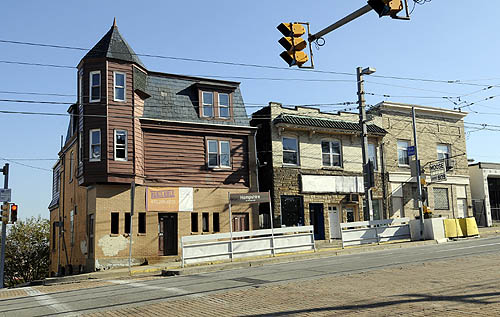
The city's Urban Redevelopment Authority has foreclosed and put on the market four buildings -- 1600, 1601, 1602 and 1619 Broadway Ave. == with hopes of enticing developers to invest in this business district and begin its turnaround. Larry Roberts/Post-Gazette
The panoramic views of the South Hills from the third-floor balcony of 1600 Broadway Ave. are a sight for sore eyes — especially if you live in Beechview.
For the last five years, residents of that city neighborhood and riders on the LRT have had to look at mostly shuttered storefronts on Broadway that were bought — then abandoned — by investor Bernardo Katz. The city’s Urban Redevelopment Authority has foreclosed and put on the market four buildings — 1600, 1601, 1602 and 1619 Broadway Ave. — with hopes of enticing developers to invest in this business district and begin its turnaround.
“Beechview is a very cool neighborhood,” said URA Director Rob Stephany. “I think its proximity to the T makes it interesting.”
Mr. Katz defaulted on millions of dollars worth of mortgages and more than $700,000 in loans from the URA that he used to buy these and other commercial properties in Beechview, Oakland and Mt. Lebanon. He fled to his native Brazil in December 2007 and was charged in absentia last year with federal wire and mortgage fraud.
Although most of the buildings were left to deteriorate, Mr Katz worked on the exterior and interior of the first floor of 1600 Broadway and briefly opened a Mexican restaurant there. The largest of the four, it’s now priced at $194,800. The newer storefront reflects its early 1900s construction while the second and third floors have a total of five apartments and another in the basement, with walkout access on Hampshire Avenue. The URA gutted the apartments to the plaster lathe, removing asbestos and all mechanical systems.
“That’s the way developers want it,” said Dave Majcher, URA senior construction coordinator.
Also gutted was the adjoining 1602 Broadway ($43,000), a former bar that has a new roof and a rickety rear addition that the URA says should be removed. Across the street is 1601 Broadway ($130,000), another former bar with a turret and a few architectural details that survived previous remodels — an original staircase and a columned fireplace mantel on the second floor. The views from its second- and third-floor windows are classic Pittsburgh, with small houses clustered along hilly streets.
A half-dozen storefronts separate 1601 from 1619 Broadway ($70,000), a small former video store with an intact three-bedroom apartment behind.
“It’s perfect for a small business owner,” Mr. Stephany said. “Someone could be in at a reasonable cost.”
The other three buildings, however, are suitable only for developers, he said. A feasibility study the URA commissioned last year estimated exterior and interior renovation costs at $588,799 for 1600 Broadway, $409,586 for 1601 and $457,866 for 1602.
“These are probably $600,000 events,” Mr. Stephany said.
Even with façade grants and streetscape loans, buyers would still be looking at construction loans of at least $400,000 for each building. Everything is not bleak, however. IGA plans to reopen the shuttered Foodland next to 1602 Broadway, and brothers Kevin and Adam Costa have purchased 1603 Broadway to open their Crested Duck Charcuterie, “an artisanal meat market.” At least initially, the apartments may be the hotter part of the properties.
“I do think the first floors will come,” Mr. Stephany said. “I’m not sure they will come first.”
Susheela Nemani-Stanger, a URA project development specialist, believes loft apartments would suit college students who appreciate their proximity to mass transit.
“They would be perfect for students from the Art Institute or Culinary Institute,” she said.
For more information on 1600, 1601, 1602 or 1619 Broadway Ave., Beechview, call 412-255-6612 or go to www.buyintheburgh.com.
SALES SNAPSHOT16TH WARD/SOUTH SIDE 2009 2010 SALES 138 147 MEDIAN PRICE $45,000 $62,000 HIGHEST PRICE $505,000 $380,000 17TH WARD/SOUTH SIDE 2009 2010 SALES 143 134 MEDIAN PRICE $121,250 $137,000 HIGHEST PRICE $800,000 $595,000 18TH WARD/MOUNT WASHINGTON 2009 2010 SALES 141 137 MEDIAN PRICE $12,000 $13,000 HIGHEST PRICE $750,000 $669,000 19TH WARD/BROOKLINE 2009 2010 SALES 462 467 MEDIAN PRICE $65,000 $68,000 HIGHEST PRICE $625,000 $465,000 20TH WARD/WEST END 2009 2010 SALES 245 208 MEDIAN PRICE $33,000 $31,800 HIGHEST PRICE $200,000 $255,000 29TH WARD/CARRICK 2009 2010 SALES 121 148 MEDIAN PRICE $49,000 $45,000 HIGHEST PRICE $133,000 $147,500 30TH WARD/KNOXVILLE 2009 2010 SALES 58 54 MEDIAN PRICE $9,900 $10,100 HIGHEST PRICE $77,000 $55,000 31ST WARD/LINCOLN PLACE 2009 2010 SALES 45 72 MEDIAN PRICE $66,000 $63,000 HIGHEST PRICE $147,400 $335,000 32ND WARD/OVERBROOK 2009 2010 SALES 115 119 MEDIAN PRICE $67,000 $73,000 HIGHEST PRICE $226,000 $229,550 MOUNT OLIVER 2009 2010 SALES 58 55 MEDIAN PRICE $16,201 $20,000 HIGHEST PRICE $79,500 $76,500 WEST HOMESTEAD 2009 2010 SALES 17 23 MEDIAN PRICE $43,100 $22,000 HIGHEST PRICE $169,900 $125,000 Beechview
At a glance- Website: www.beechview.org
- Size: 1.46 square miles
- Population: 8,772 (2000 census)
- School district: Pittsburgh Public (pghboe.net)
- Enrollment: 25,326
- Average 2010 SAT scores: 425 verbal, 446 math, 423 writing
- Taxes on a property assessed at 100,000 : $2,870; City: $1,080 (10.8 mills), school district: $1,392 (13.92 mills), county: $398 (4.69 mills), wage tax: 3 percent (1 percent to the city, 2 percent to the school district)
- Claim to fame: Named for the many beech trees found on its hillsides, Beechview (incorporated as a borough in 1905 and annexed to the city four years later) has the steepest street in hilly Pittsburgh, and quite possibly the world. Canton Street has a grade of 37 percent — that is, it rises 37 feet per 100 feet of run. So steep is the bottom half, that residents aren’t supposed to drive down it.
-
Schwartz Market Alive and…Well, Hoping to Sell
Wednesday, November 10, 2010 08:00 AMStaff Blogs by the Pittsburgh Post-Gazette
Written by Diana Nelson Jones
Since I reported in May that Schwartz Market had a buyer, shoppers have assumed that the little store on East Carson Street had gone out of business.
Not so! Schwartz Market at 1317 E. Carson, is alive and wants you to know it will remain alive until a buyer actually comes through. An IGA grocer had signed a letter of intent in May but backed out of the deal because the building needed upgrades that the building owners have not made.
The building is owned by family of the founding grocers, who once operated six Schwartz Markets in the city. The South Side market, which is on Facebook, has been in operation since the 1920s.
Marty and Audrey Dorfner and Rick and Donna Stanton bought the business in 1985 and have operated it continuously since.
“My goal is to retire after 54 years in this [grocery] business,” said Marty, who has another grocer showing interest in the store.
Until then, said Donna, “We will be here because we want the neighborhood to be served.”
They are gearing up to meet your holidays needs with the kielbasa and sausages for which they are known.
My article was based on information that made the deal appear to be a sure thing. A lot of articles in the paper are anticipatory, such as economic development groundbreakings on ground that three years later have yet to see another shovel.
It’s one thing when there’s nothing there anyway; it’s another when a business suffers as a result. Our city neighborhoods need small retailers; remember to support them in these lean times.
-
Church Will Be Turned into Condos
Saturday, November 06, 2010By Marylynne Pitz, Pittsburgh Post-GazetteBy next summer, Madonna del Castello Church in Swissvale will be transformed into four condominiums.
Located at 7416 Duquesne Ave., the former Roman Catholic church has been empty for the last five years, said Patrick Shattuck, senior real estate developer for the Mon Valley Initiative.
Mt. Zion Fire Baptized Holiness Church of God of America purchased the church from the Diocese of Pittsburgh in 1987 for $55,000. About five years ago, the congregation moved out, Mr. Shattuck said. In September, Mon Valley Initiative purchased the property for $10,000.
The church has a front Flemish-style gable, a barrel-vaulted ceiling and a large dome over the altar; all of these elements will be incorporated into the redesign.
“The space will certainly be dramatic with the high, barrel-vaulted ceilings. The altar will become a dining room with the dome over it,” Mr. Shattuck said.
The building has been reconfigured by Lami Grubb Architects; renovations will be done by Mistick Construction. The building has stood empty and open to the elements, sustaining major water damage.
“The congregation that took it over actually put a dropped ceiling in. They were unaware that the water damage was substantial. So, they repaired the roof but a good portion of the plaster ceiling fell onto the dropped ceiling. That was when they were forced to move out,” Mr. Shattuck said.
The plaster was actually helping to hold the building together, he said. When structural engineers examined the building, they found gaps between the walls.
“You can see daylight between the front wall and the side walls,” Mr. Shattuck said.
Three of the new units will have 1,600 square feet, two bedrooms and 1 1/2 baths and be priced at $85,000. The fourth unit, which incorporates the dome over the altar, will have three bedrooms, 2 1/2 baths, a study and 2,400 square feet of space. It will cost $105,000.
Asbestos has been removed and the red brick exterior is being cleaned. Cast plaster moldings, six Corinthian capitals and arches in the church will be recast and incorporated into the design. The church sits on a quarter of an acre and there will be off-street parking for residents.
“We own a double adjacent lot next to it. There were two buildings that we had to demolish. It may be that we develop a single new house on the site or it may be that it becomes a community garden space,” Mr. Shattuck said.
-
Setback Won’t Deter Move of Historic House
Friday, November 05, 2010By Len Barcousky, Pittsburgh Post-GazettePaul Orange hasn’t given up hope that he will be able to buy and relocate the historic William Smith House in Mercersburg, despite a setback Thursday.
The house is on land owned by the MMP&W Volunteer Fire Co., which acquired the property in 2009 with plans to expand its aging facilities.
The board that oversees the regional fire company opened bids on Thursday for demolishing the 260-year-old structure but did not consider a proposal from Dr. Orange to move it.
Contacted after the meeting, Dr. Orange said he was advised that his offer to pay the fire company $100 for the building, rather than charge for tearing it down, had not been submitted in the right form.
The fire board, however, took no action on the demolition bids it received during its 15-minute meeting. That decision gives him hope that he still can reach an agreement to preserve the house, he said.
Joel Bradnick, a spokesman for the fire board, said the five bids would be forwarded to the fire company’s engineer for evaluation. He described Dr. Orange’s offer as a nonbinding “one-line memo.”
The low bid for demolition was $18,000.
“But why pay $18,000 to knock something down when you have someone willing to give them money to take it away,” Dr. Orange said.
The fire station and the Smith House are next to each other on Mercersburg’s Main Street.
If he is able to reach an agreement to move the house — either with the fire company or with the firm chosen to do the demolition — the next likely step would be to acquire a new location nearby. One possibility is a lot on the other side of Main Street, the site of a closed gas station.
Relocation and land acquisition could cost him as much as $100,000.
The Smith House was built in the 1750s. Constructed as a one-story cottage, it was greatly modified in the 19th and 20th centuries with the addition of a second story and porches.
News that the Smith House might be demolished attracted the interest of a museum in Northern Ireland. The Ulster American Folk Park has been developing plans to rescue the 18th-century first floor of the structure and move it to Europe. There it would become part of a collection of buildings with ties to Scotch-Irish immigration history. Several structures at the outdoor museum were moved from their original sites in southwestern Pennsylvania.
Worries about demolition also resulted in the formation of a small citizens group called the Committee to Save the William Smith House. Committee members have thrown their support behind Dr. Orange’s efforts to move the building.
“I hope we all can come together in a goodwill effort to restore this important piece of history,” said Karen Ramsburg, president of the Smith House committee. “This is America’s house, and I think it could become a real tourism magnet near the Interstate 81 corridor.”
Mercersburg is about 150 miles southeast of Pittsburgh. It is about 10 miles west of the Greencastle exit of I-81.
William Smith, an 18th-century businessman and local magistrate, was one of the leaders of what historians describe as the earliest organized opposition to British rule of its American colonies.
His home was a meeting place in 1765 for mostly Scotch-Irish settlers who organized themselves into armed bands. They formed a local militia after concluding that neither the Quaker-dominated colonial government in Philadelphia nor British officials in London were able to protect them from Indian raids.
William Smith’s brother-in-law, James Smith, was the leader of a group of settlers known as the “Black Boys,” who disguised themselves with paint and Indian clothes. Armed and angry, the Black Boys stopped pack trains traveling from Philadelphia to Fort Pitt that they believed were carrying weapons and ammunition that would end up in the hands of their Native American enemies.
After the British sent troops to nearby Fort Loudon to protect the traders and arrest the Black Boys, the soldiers twice found themselves besieged by the frontier militia.
The shots fired in 1765, 10 years before the Battles of Lexington and Concord, could be called the opening shots of the American Revolution, supporters of the Smith House say.
Dr. Orange describes himself as a history buff. A Westmoreland County native, he is a graduate of Greensburg Central Catholic High School and Saint Vincent College. He has a family medical practice on Route 30, east of Chambersburg.
-
Civic Arena Seats, Other Items Up for Sale or Bid
Thursday, November 04, 2010By Mark Belko, Pittsburgh Post-GazetteFans will have a chance to buy seats and other memorabilia from the Civic Arena over the next two months through on-line sales.
The city-Allegheny County Sports & Exhibition Authority approved an agreement this morning with the Penguins related to the sale of assets from the Igloo, which closed at the end of July.
Seats from the arena will go on sale to Penguin season ticket holders in the next few days, a sale that will run until Nov. 30. That will be followed by a sale to the general public on Dec. 1. A pair of seats will cost $495. Buyers can choose from red, blue, black and, of course, orange seats, but they will not be able to request individual seat numbers. About 5,000 seat pairs will be available for purchase.
The seat sale will be followed by an online auction Dec. 8 for other arena memorabilia, some of which will include Penguins logos or the signatures of players.
Bidding for the memorabilia will start about two weeks before Dec. 8. The highest bidder will be awarded the items. Those who have placed a bid will be notified if they have been outbid leading up to the closing Dec. 8.
“Although I don’t like this phrase, it’s very similar to eBay,” said Shawn Allen, chief operating officer for AssetNation, which is handling the sale.
The first online auction will be on Nov. 17 for arena furniture.
All of the seat transactions will take place on www.iglooseats.com
Bidding will be conducted at www.asset-auctions.com
Those who don’t have access to the Internet can call 1-800-303-6511 for a paper bid form.
The sale is expected to generate $1.6 million for the SEA and $800,000 for the Penguins, who will donate their share to their foundation.
The SEA’s share ultimately could be used to help pay for the demolition of the iconic 49-year-old domed building to make way for redevelopment.

